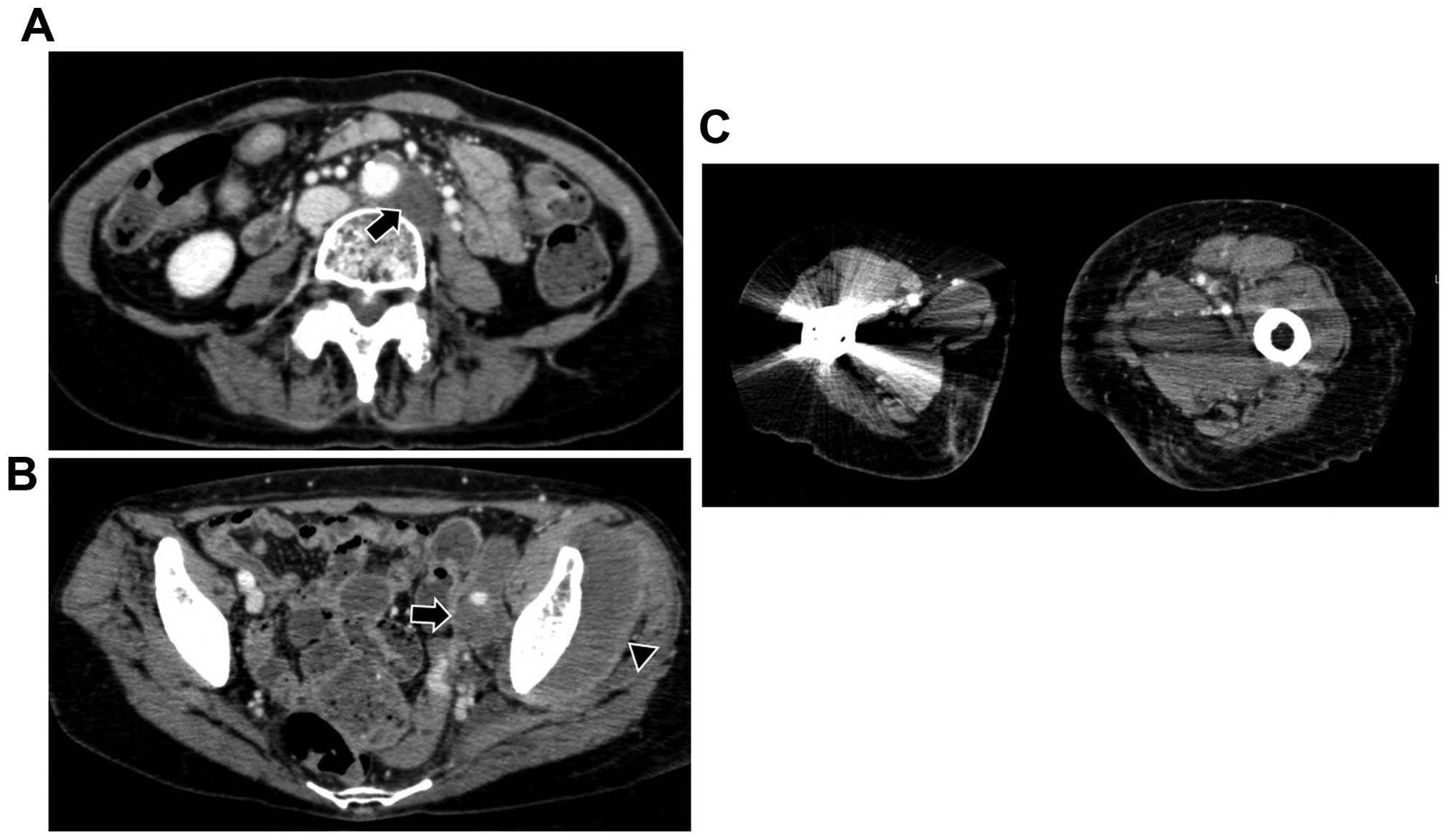Lower limb lymphedema in lung adenocarcinoma: Two case reports
- Authors:
- Misae Shinoda
- Haruka Akutsu
- Toshihiro Ohtani
- Tomohiro Tamura
- Hiroaki Satoh
-
View Affiliations
Affiliations: Division of Nursing, Mito Medical Center, University of Tsukuba, Mito, Ibaraki 310‑0015, Japan, Division of Pharmacy, Mito Medical Center, University of Tsukuba, Mito, Ibaraki 310‑0015, Japan, Division of Respiratory Medicine, Mito Medical Center, University of Tsukuba, Mito, Ibaraki 310‑0015, Japan
- Published online on: August 10, 2016 https://doi.org/10.3892/mco.2016.988
-
Pages:
478-479
Metrics:
Total
Views: 0 (Spandidos Publications: | PMC Statistics:
)
Metrics:
Total PDF Downloads: 0 (Spandidos Publications: | PMC Statistics:
)
This article is mentioned in:
Abstract
Breast and gynecological cancers and their treatment may cause lymphedema of the upper and lower extremities, respectively. We herein report the cases of two patients with lung adenocarcinoma who developed lymphedema of the lower extremities. One patient harbored an epidermal growth factor receptor mutation and the other patient harbored an anaplastic lymphoma kinase fusion gene. The patients had developed intra‑abdominal lymph node metastases and received several lines of chemotherapy. In both patients, lymphedema in the lower extremities developed >30 months after the initiation of first‑line chemotherapy. To the best of our knowledge, these are the first reported cases of lung cancer patients who developed lymphedema in the lower extremities. Although rarely, lymphedema of the lower extremities may develop long after successful therapy with molecular‑targeted therapy in advanced lung adenocarcinoma patients with a specific genetic etiological background.
View References
|
1
|
Jakes AD and Twelves C: Breast
cancer-related lymphoedema and venepuncture: A review and
evidence-based recommendations. Breast Cancer Res Treat.
154:455–461. 2015. View Article : Google Scholar : PubMed/NCBI
|
|
2
|
Casey C, Chen LM and Rabow MW: Symptom
management in gynecologic malignancies. Expert Rev Anticancer Ther.
11:1077–1089. 2011. View Article : Google Scholar : PubMed/NCBI
|
|
3
|
Bareschino MA, Schettino C, Rossi A,
Maione P, Sacco PC, Zeppa R and Gridelli C: Treatment of advanced
non small cell lung cancer. J Thorac Dis. 3:122–133.
2011.PubMed/NCBI
|
|
4
|
Thomas A, Liu SV, Subramaniam DS and
Giaccone G: Refining the treatment of NSCLC according to
histological and molecular subtypes. Nat Rev Clin Oncol.
12:511–526. 2015. View Article : Google Scholar : PubMed/NCBI
|
|
5
|
Gerber DE, Gandhi L and Costa DB:
Management and future directions in non-small cell lung cancer with
known activating mutations. Am Soc Clin Oncol Educ Book.
2014:e353–e365. 2014. View Article : Google Scholar
|
|
6
|
Togashi Y, Hayashi H, Nakagawa K and
Nishio K: Clinical utility of erlotinib for the treatment of
non-small-cell lung cancer in Japanese patients: Current evidence.
Drug Des Devel Ther. 8:1037–1046. 2014. View Article : Google Scholar : PubMed/NCBI
|
|
7
|
Le Rhun E, Taillibert S and Chamberlain
MC: Carcinomatous meningitis: Leptomeningeal metastases in solid
tumors. Surg Neurol Int. 4(Suppl 4): S265–S288. 2013.PubMed/NCBI
|
|
8
|
Petrek JA and Heelan MC: Incidence of
breast carcinoma-related lymphedema. Cancer. 83:(12 Suppl
American). S2776–S2781. 1998. View Article : Google Scholar
|
|
9
|
Beesley V, Janda M, Eakin E, Obermair A
and Battistutta D: Lymphedema after gynecological cancer treatment:
Prevalence, correlates and supportive care needs. Cancer.
109:2607–2614. 2007. View Article : Google Scholar : PubMed/NCBI
|
|
10
|
Loh SY and Musa AN: Methods to improve
rehabilitation of patients following breast cancer surgery: A
review of systematic reviews. Breast Cancer (Dove Med Press).
7:81–98. 2015.PubMed/NCBI
|










